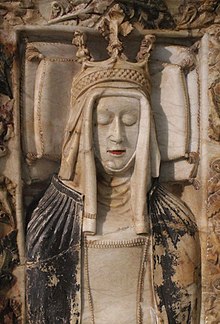
Back بياتريس من البرتغال Arabic بياتريس من البرتجال (عاهله من مملكه البرتجال) ARZ Beatriz Portugal (1372-1410) Breton Beatriu de Portugal Catalan Beatrix Portugalská Czech Beatrix von Portugal German Βεατρίκη της Πορτογαλίας Greek Beatriz de Portugal (reina) Spanish Beatriz (Portugali) Finnish Béatrice de Portugal (1373-1412) French
| Beatrice of Portugal | |
|---|---|
 Effigy of Queen Beatrice, Monastery of Sancti Spiritus in Toro, Zamora, Spain. | |
| Queen consort of Castile and León | |
| Tenure | 17 May 1383 – 9 October 1390 |
| Queen of Portugal | |
| Reign | 1383–1385[1][2][3][4][5][6] |
| Predecessor | Ferdinand I |
| Successor | John I |
| Regent | Leonor Teles |
| Born | 7–13 February 1373[7][8] Coimbra, Portugal |
| Died | c. 1420 (aged 46–47)[9] Castile |
| Burial | |
| Spouse | |
| House | Burgundy |
| Father | Ferdinand I of Portugal |
| Mother | Leonor Teles |
Beatrice (Portuguese: Beatriz, pronounced [bi.ɐˈtɾiʃ]; 7–13 February 1373 – c. 1420) was the only surviving legitimate child of King Ferdinand I of Portugal and his wife, Leonor Teles. She became Queen consort of Castile by marriage to King John I of Castile. Following her father's death without a legitimate male heir, she claimed the Portuguese throne, but lost her claim to her uncle, who became King John I of Portugal, founder of the House of Aviz.
During her early years, Beatrice was a pawn in the changing politics of foreign alliances of her father, who negotiated successive marriages for her. She would eventually marry King John I of Castile, by whom Beatrice became Queen consort of Castile. At the death of her father, Beatrice was proclaimed Queen regnant of Portugal and her mother assumed the regency in her name. Opposition to the regency, fear of the Castilian domination and loss of Portuguese independence[10] led to a popular rebellion and civil war[11] between the late King Ferdinand I's illegitimate brother, John of Aviz, who wrested control of the regency from the dowager queen, and the supporters of Beatrice and her husband, John I of Castile, who claimed the throne of Portugal by right of his wife. In 1385, John of Aviz was proclaimed King of Portugal, and the King of Castile was definitively defeated in the Battle of Aljubarrota, effectively ending any prospects for Beatrice and her husband to assert their rights to the Portuguese crown.
From that time, Queen Beatrice took a special interest in the welfare of the Portuguese exiles in Castile who had been faithful to her dynastic claim to the Portuguese throne. After the death of her husband she was relegated to a secondary level in the Castilian court. However, the dynastic strife continued to represent a challenge to the normalization of relations between Castile and Portugal. From the second decade of the 15th century onwards, her documentary trail became scarce until she completely disappears about 1420.
- ^
Earenfight, T. (2010). Women and Wealth in Late Medieval Europe. Springer. p. 221. ISBN 978-0230106017.
Beatriz Queen 1383-1385
- ^ Monter, William (2012-01-24). The Rise of Female Kings in Europe, 1300-1800. Yale University Press. p. x. ISBN 978-0-300-17327-7.
5. (1383) Beatriz of Portugal, ten, succeeds father; married but deposed 1385 by illegitimate half brother;
- ^ Bartlett, Robert (9 July 2020). Blood Royal: Dynastic Politics in Medieval Europe. Cambridge University Press. p. 447. ISBN 978-1108490672.
Beatrice of Portugal (1383-5)+
- ^ Dresvina, Juliana; Sparks, Nicholas, eds. (18 December 2012). Authority and Gender in Medieval and Renaissance Chronicles. Cambridge Scholars. p. 376. ISBN 978-1443844284.
Beatrice of Portugal (contested queen, 1383-85),
- ^ Bolton, Brenda; Meek, Christine (2007). Aspects of Power and Authority in the Middle Ages. Brepols. p. 132. ISBN 978-2503527352.
As to Beatriz (1383-85), acclaimed queen after her father's death in 1383, she was deposed two years later,
- ^ Merino, Vicente Salas (2015-04-06). La Genealogía de Los Reyes de España 5º edición (in Spanish). Vision Libros. p. 294. ISBN 978-84-16284-27-6.
1383-1385 BEATRIZ = JUAN I DE CASTILLA
- ^ Cronicom Conimbricense, in Chronicles of López de Ayala, book II, p. 592.
- ^ Salvador M. Dias Arnaut in A crise nacional dos fins do século XIV (1960), indicates that the date of her birth would be between 7 and 13 of February, though according to Olivera Serrano the marriage contract of 1383 gave 1 March as her birthday. Olivera Serrano 2005, p. 57.
- ^ Olivera Serrano 2005, p. 392.
- ^ Ayala's Chronicles, Madrid's edition 1780, book II, since page 292.
- ^ Newitt, M. D. D. (2004-10-14). A History of Portuguese Overseas Expansion 1400–1668. Routledge. p. 16. ISBN 978-0-415-23979-0.